Here you will find the best cactus and succulents that hang down. You will love it.
Senecio Rowleyanus (String of Pearls, String of Peas)
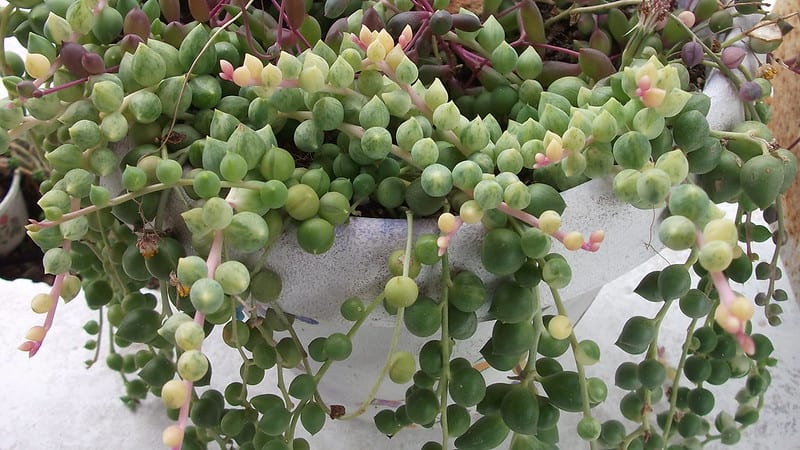
If you’re looking for an easy succulent to grow indoors, opt for the string of beads (Senecio rowleyanus) plant.
In addition to its carefree growth habit, this interesting houseplant can provide a unique focal point in the home.
You may like Crassula Tetragona
Sprawling over the edges of containers or hanging baskets, the string of beads plant resembles a beaded necklace with its fleshy green, pea-like foliage.
Learn more about growing string of beads houseplant so you can also enjoy its unique characteristics and ease of care.
What is a String of Beads Houseplant? Also called rosary string of beads or string of pearls plant, this creeping succulent is an odd looking plant that many people enjoy adding to their indoor gardens.
Though the flowers may seem small and unattractive to some people, if they’re even lucky enough to get them, others find the faint white blooms (which smell a bit like cinnamon) quite welcome.
Still, it’s the thin thread-like stems and fleshy round, bead-like leaves that make this unusual houseplant a great addition to the home. Learning how to grow a string of pearls houseplant is extremely easy.
Senecio Herreianus (String of Beads)
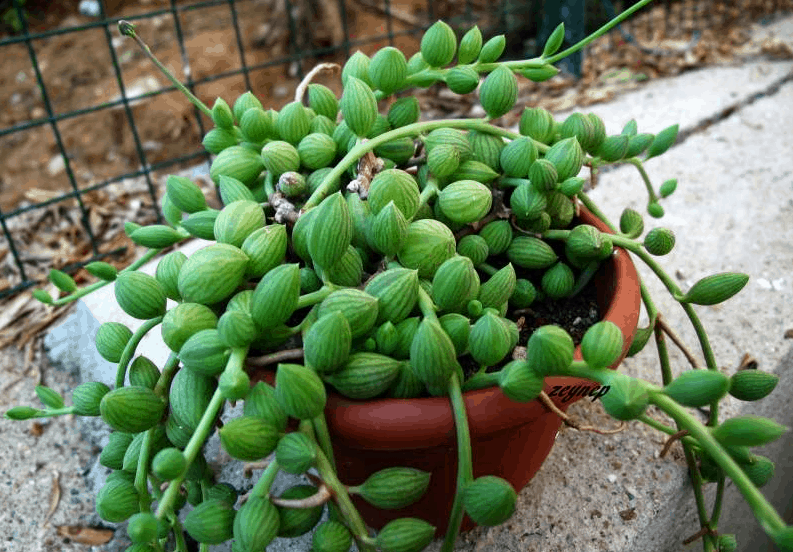
Senecio herreianus is commonly known as String of Beads after its creeping stems and interesting spherical, pea-like foliage with tiny slightly pointed tips.
It has a more compact form then it’s close relative Senecio rowleyanus (known commonly as string of pearls) and it’s leaves vary in size.
Sprawling over the edges of containers or hanging baskets, this perennial, succulent species resembles a beaded necklace.
It is easy to grow indoors and is very regularly kept as a houseplant around the world.
In the wild, when the trailing stems touch the ground they tend to root and form dense mats.
Originating from arid environments, this species is adapted to store water for periods of drought.
Scented blooms may appear during the summer, these are trumpet-shaped, white and may have colourful stamens.
This succulent likes more water than most and prefers to be in a position of partial shade rather than full direct sunlight.
Senecio Radicans (String of Bananas)
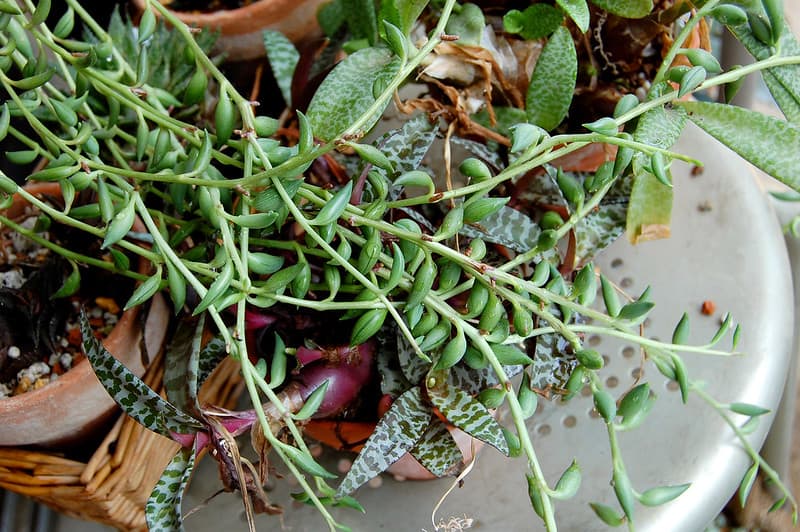
This popular trailing succulent has leaves that are shaped like bananas or fish hooks, and if grow in the ground instead of in a hanging garden, “String of Bananas” can trail along the ground.
When cared for properly, this succulent grows quickly, and is easily propagated.
Senecio radicans “String of Bananas” is a common trailing succulent.
For succulent growers who love “String of Pearls” but find it difficult to grow, “String of Bananas” is a great alternative. It is easier to keep alive and much less fussy.
Fish Hook Senecio or Grey Fishhooks Senecio
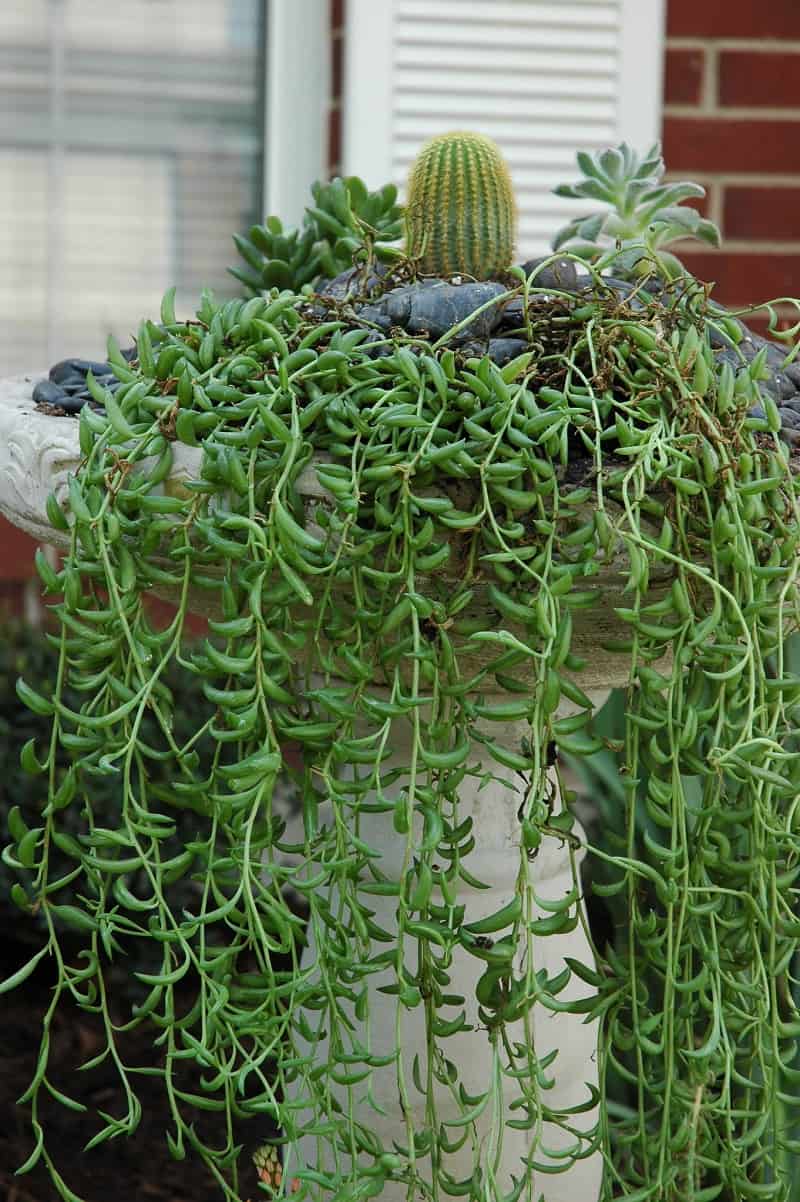
If you want an easy-care plant that trails like crazy, then call off the search – you’ve found it.
The Fishhooks Senecio (some call the ones I have Grey Fishhooks Senecio) likes to ramble and at 4′ long, shows no signs of slowing down.
This succulent loves any admiration you can throw its way but is not fussy at all when it comes to caring. Mine grow outdoors make excellent houseplants.
This plant also goes by the names Fishhooks Plant, String Of Fishhooks, Senecio “Fish Hooks ” as well as by its botanic moniker Senecio radicans.
This is a bit confusing because there’s another succulent (which you see at the end of this post) that I know as String Of Bananas which also has the botanic name Senecio radicans.
No matter what you call the plant I’m showcasing, it trails like crazy & is a snap to maintain.
Dischidia Nummularia (String of Nickels)
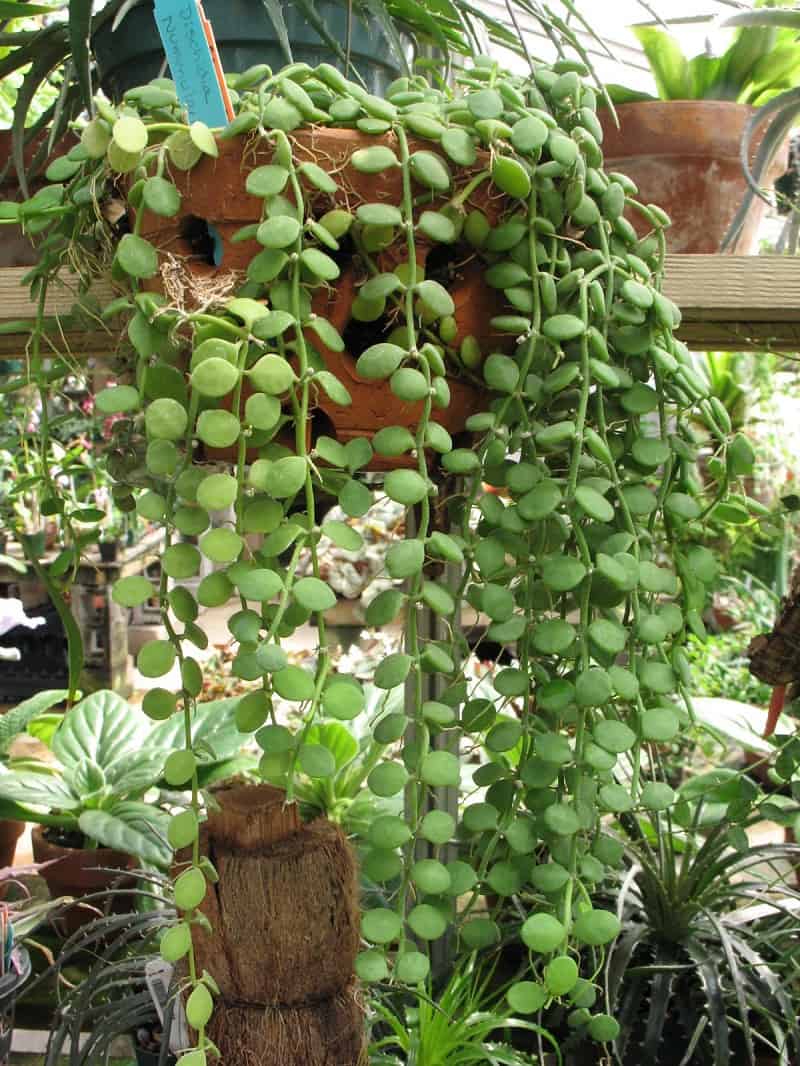
Dischidia nummularia is commonly called “Button Orchid or ” String of Nickels”.
In its native habitat of New Guinea and Australia, it grows as an epiphyte hanging from the trees.
The leaves are very thick and grey green in color.This makes an excellent plant for mounting in the greenhouse or in a large terrarium or vivarium.
The flowers are tiny, white and waxy. Keep fairly dry.
Shade to partial shade, 45 to 95 degrees, trailing to several feet. allow getting fairly dry between watering
Crassula Pellucida Variegata (Calico Kitten)
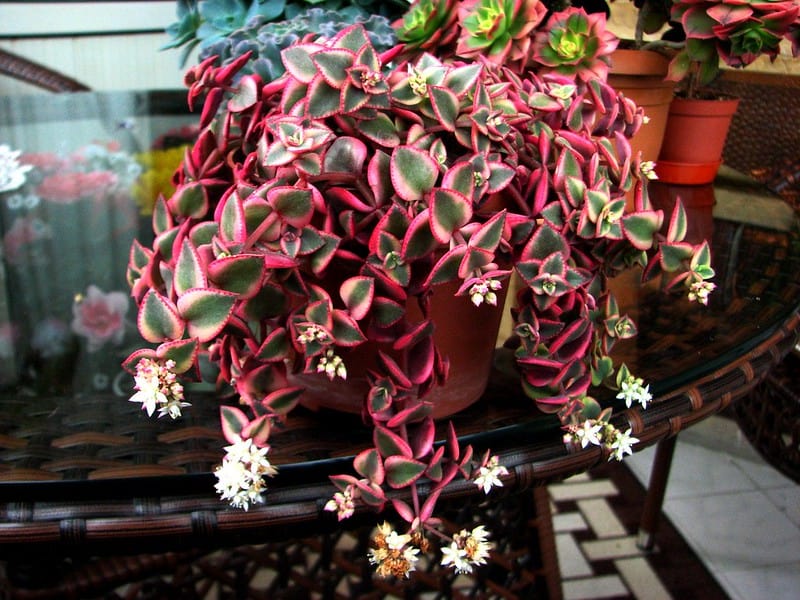
Native to South Africa, Crassula Pellucida ‘Variegata’ (Calico Kitten) is such a beautiful plant the pictures I have do not do it justice.
Perhaps I should learn to take better pictures because I really cannot get a good enough picture of this plant to capture all its intricate details, colors and beauty.
Care for this plant can be tricky in the beginning, but they harden with time and with proper care.
Slow growers at first, they can be vigorous growers once they get going. They are low growing plants and tend to spread out or spill over the sides of the pot instead of growing tall.
Ceropegia Linearis Woodii (String of Hearts, Rosary Vine)
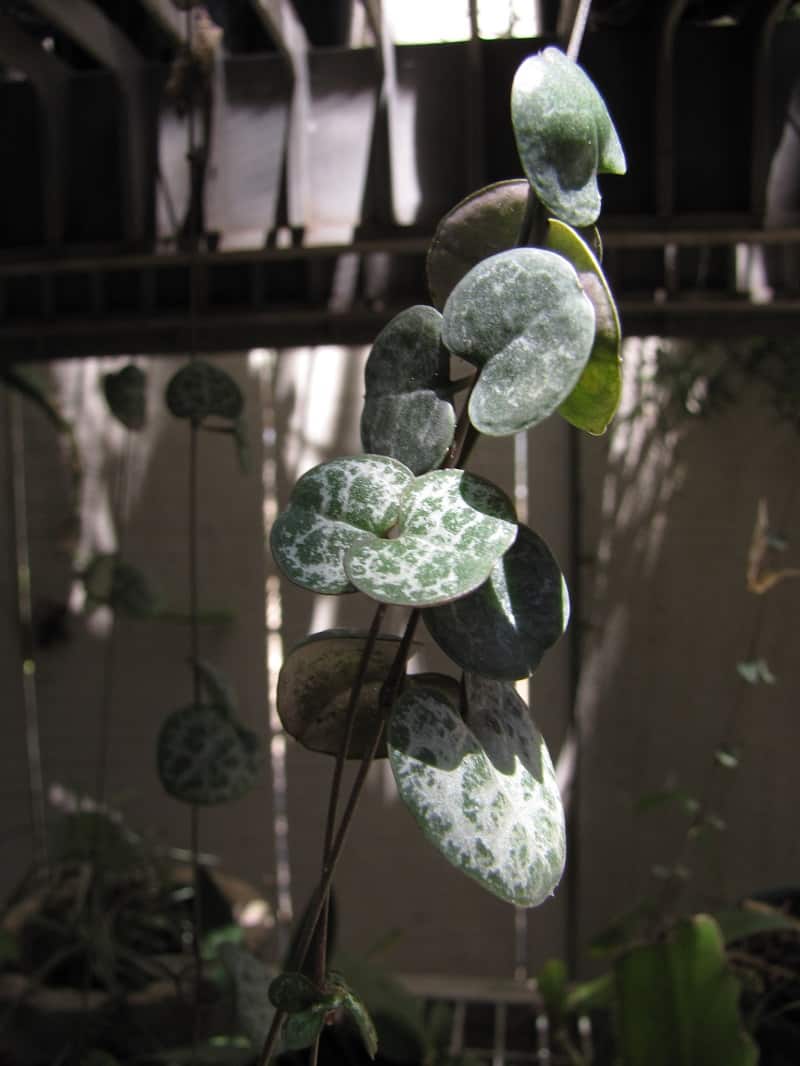
Rosary vine is a plant full of distinctive personality.
The growth habit appears to resemble beads on a string like a rosary, and it is also called string of hearts.
Rosary vine string of hearts is native to Africa and makes an excellent houseplant. Rosary vine plant care outdoors requires a location in USDA zones 10 and above.
Otherwise, rosary vine houseplants are the solution if you wish to grow this funky little plant.
Ceropegia woodii is the scientific designation for the wiry stemmed plant. Rosary vine houseplants have pairs of heart-shaped leaves about every 3 inches (8 cm.) along the slender stem.
The sparse foliage adds to the unique look of the plant. The leaves are etched lightly on the top surface with white and on the underside with purple.
The stems drape over a pot or container and hang down to 3 feet (91 cm.). Little bead-like structures form on the stems at intervals between the leaves.
Rosary vine plant care is minimal and the string of hearts has a high heat tolerance and light requirement. Choose the sunniest room of the house for growing Ceropegia rosary vine.
he little bead-like pearls on the stems are called tubercles, and form after the plant has produced small tube-like purple flowers.
The tubercles will root and produce another plant if the stem touches soil .
If you are just in love with your plant and wonder how to grow rosary vines to share, take a look at the tubercles.
You can pull them off, lay them on the surface of the soil and wait for roots. It is that simple to propagate and grow rosary vines.
Rosary vine houseplants are old-fashioned indoor greenery that enchant with their thick heart-shaped leaves and slim stiff stems.
Use a container with good drainage holes and plant string of hearts in average potting soil amended with one-third sand.
This vine must not be kept too wet or it is prone to rot.
Allow the soil to dry out completely between watering. The plant goes dormant in winter, so watering should be even less frequent.
Fertilize in spring with a half dilution of food every two weeks. You can cut off errant stems, but pruning is not strictly necessary.
Hoya Pachyclada”Wax Plant”
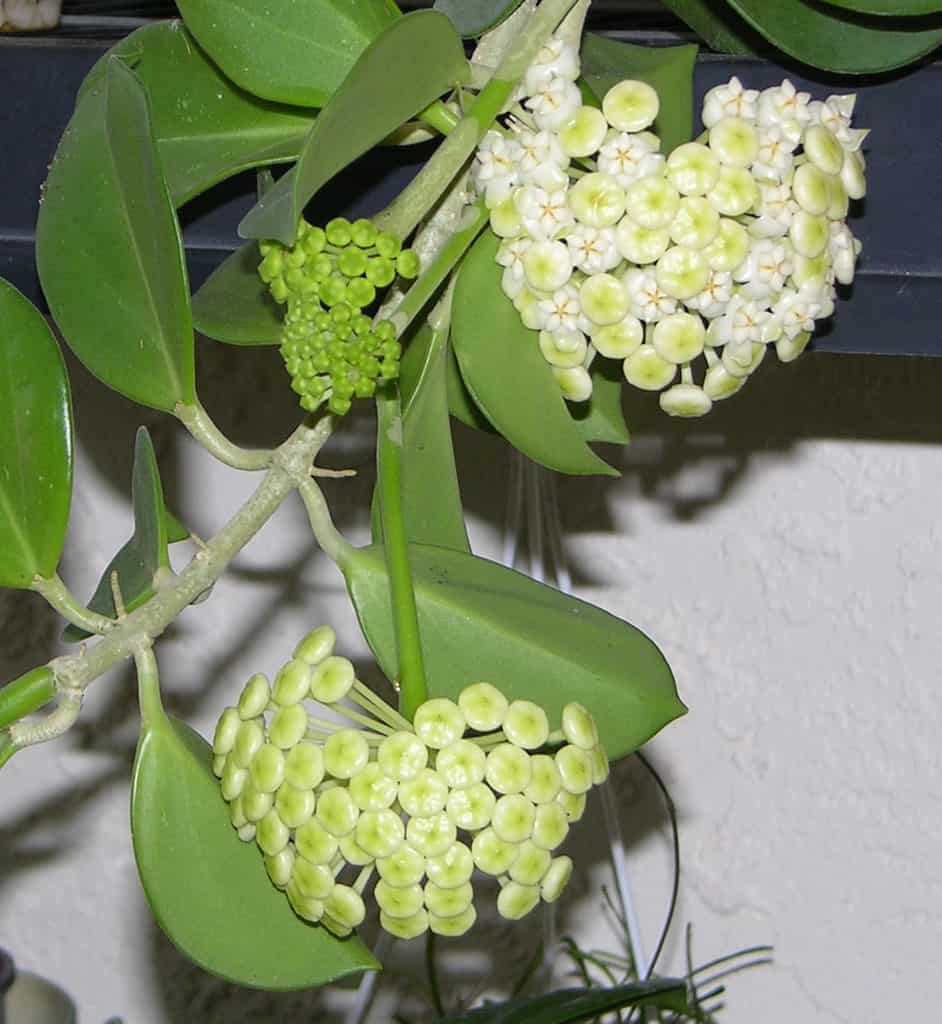
Ommon names for Hoya carnosa compacta include the Hindu rope plant, Krinkle Kurl, porcelain flower, and wax plant.
Each of these highlights a distinctive characteristic of this unique plant.
Its draping vines resemble thick ropes with their crowded, contorted leaves.
These fleshy, curled leaves, which may be either solid dark green in color or variegated green and white, have an attractive glossy or waxy appearance.
The clusters of small star-shaped flowers are also often waxy. And they are so delightfully perfect, they appear to be made of porcelain.
Hoya carnosa compacta is a popular variety of the Hoya genus to grow as a houseplant – with good reason.
This plant is great for hanging pots and ledges that will show off its verdant trailing vines.
With minimal effort, you can enjoy the Hindu rope plant’s remarkable foliage for many, many years – even decades! And with just a little patience and added attention, you will be treated to its exquisite flower clusters.
So here’s everything you need to know to take good care of a Hindu rope plant and encourage it to produce eye-catching, long-lasting blooms.
Sedum Burrito (Burro’s Tail, Baby Donkey Tail)
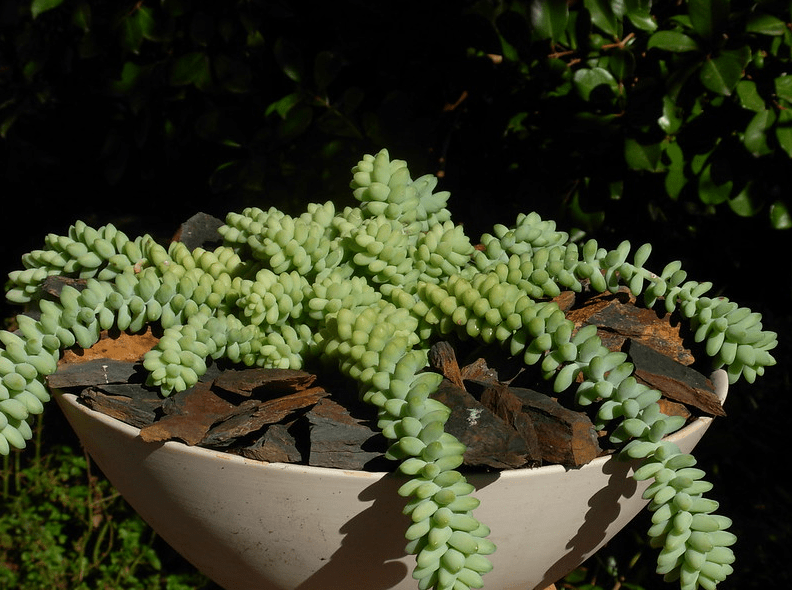
The donkey’s tail succulent (Sedum morganianum) is a popular and easy-to-grow trailing succulent with rows of fleshy, tear-drop shaped leaves.
This plant is also commonly known as lamb’s tail, burro’s tail, or horse’s tail.
Some other closely related Sedum varieties may also be known by any of these names.
These succulents make excellent hanging plants or they can be used as trailers (a plant with only one root that creeps along the surface) in small pots.
A mature specimen might have branches up to two feet long, with dozens of grey-green, plump leaves lined up like droplets.
Flowers readily emerge in late summer in hanging clusters of small blossoms. The flowers can be red, yellow, or white.
Donkey’s tails are pretty forgiving plants—if you forget to water them once or twice, they’ll probably be just fine.
Too often, these are left to fend for themselves, simply because they can.
But with a little effort, the plant can grow into a remarkable specimen.
Othonna Capensis (Little Pickles, Ruby Necklace)
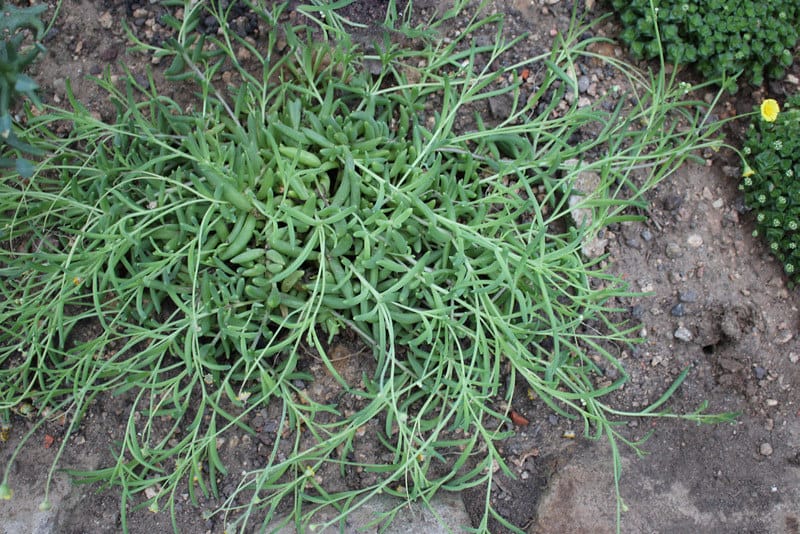
This trailing succulent has a woody stem with small green leaves that look like pickles. If happily stressed, the leaves turn a purplish red. Watch for yellow flowers in the Spring to Fall.
Othonna capensis “Little Pickles” is a great addition to rock gardens or hanging baskets. If grown in the ground, it spreads as it grows, creating ground cover. When grown in hanging baskets, it creates spectacular “spiller.”
Othonna capensis “Little Pickles” can be propagated from stem cuttings.
Aporocactus Flagelliformis (Rat Tail Cactus)
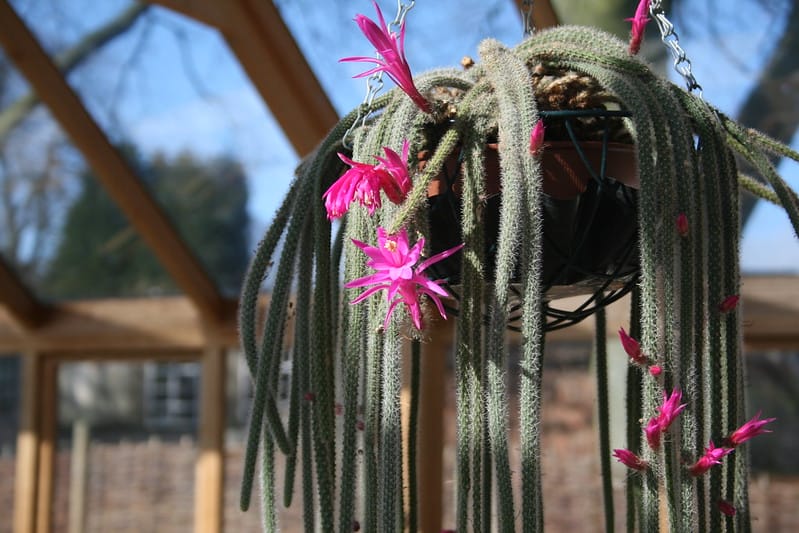
The Aporocactus flagelliformis, or rat’s tail cactus, is a showy cactus native to southwestern Mexico and parts of Central America.
It is distinctive for its long, trailing stems, which grow to about four feet at maturity and give the plant its nickname.
Rat’s tail cactus flowers in spring and early summer and its blooms are usually violet-red; however, the plant will sometimes grow flowers in idiosyncratic colors like pink and orange.
Its flowers are tubular and fairly large, about two inches wide.
Though it produces quite a few flowers during its bloom in the late spring, each flower only lives for a couple of days at most.
In the wild A. flagelliformis is either lithophytic or epiphytic, meaning it grows on the ground or on larger structures like trees; however, in cultivation, it is usually grown in hanging pots or baskets because of its trailing stems.
There are numerous varieties of the rat’s tail cactus, some of which have deeply ridged stems: the parent plant, however, has stems with shallow ridges.
It is very easy to propagate by cuttings because its stems grow so copiously.
Though its stems can be aesthetically beautiful, beware: they grow spines that can ruin your day.
Echinopsis Chamaecereus (Peanut Cactus)
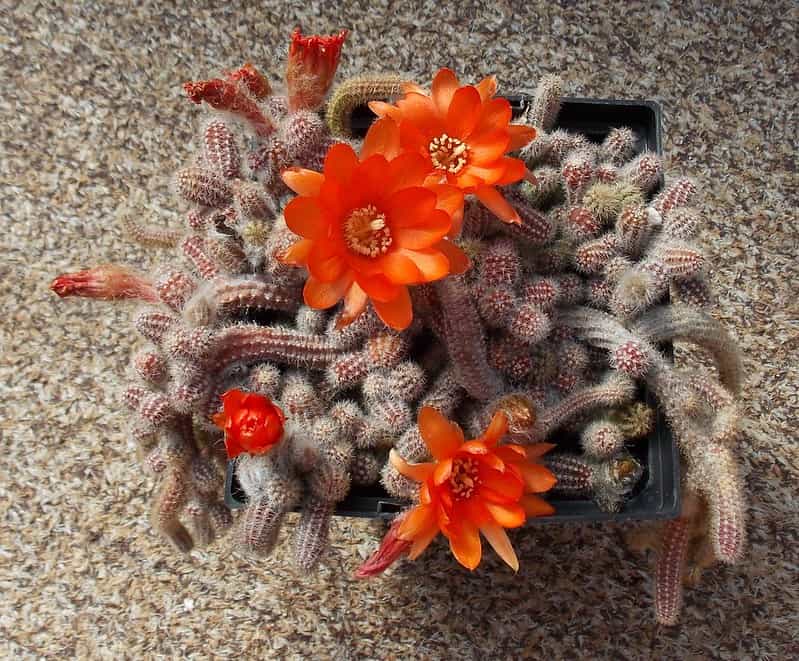
Peanut cactus is an interesting succulent with many finger-like stems and stunning spring-to-summer flowers.
If you live in a hot climate or like to grow succulents indoors, learn a little peanut cactus information to help you give it the conditions to help it thrive.
Peanut cactus is a plant native to Argentina with the Latin name Echinopsis chamaecereus.
It is sometimes called chamaecereus cactus. It is a clustering, or mat-forming, cactus with shallow roots. The stems are plentiful and shaped like fingers, or long peanuts.
They can grow up to about six inches (15 cm.) tall and 12 inches (30 cm.) wide. In the late spring and early summer, peanut cactus produces gorgeous, large, reddish-orange blooms that cover much of the cactus clump.
These cacti are popular in the garden in hot areas because of the unique appearance and pretty flowers. They grow quickly and will fill in a space in just a couple of years.
Peanut cactus care depends largely on the environmental conditions.
This is a cactus that is only hardy in zones 10 and 11, although it can also be grown as a houseplant.
It grows well outdoors in southern Florida and Texas and in dry, hot areas of California and Arizona.
Where the temperatures are particularly hot, as in Arizona, peanut cactus should be given a little shade.
In cooler areas of these zones, give it full sun. Give it as much sun as possible when grown indoors.
Hildewintera Colademononis (Monkey’s Tail)
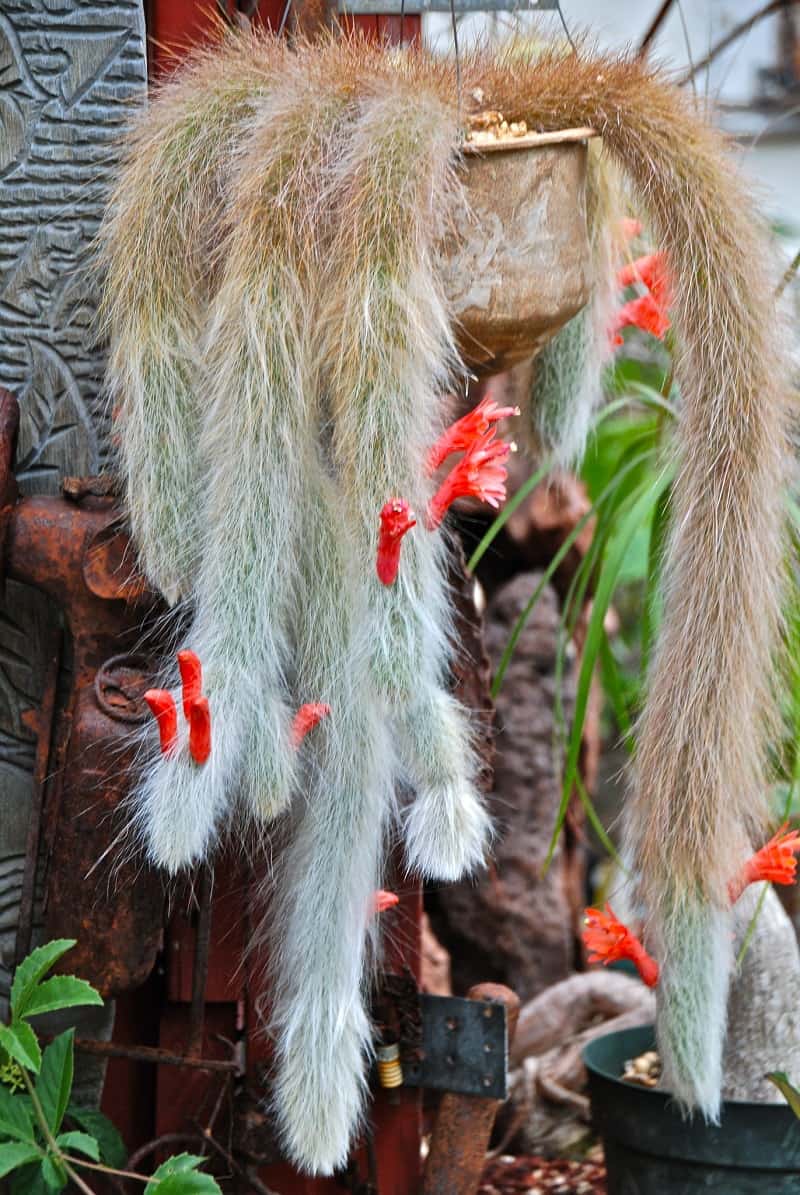
If you are a sucker for succulent plants or cacti plants in general, then this piece will most definitely tickle your fancy.
Succulents are a class of plants characteristically known to have water-filled thick leaves and branches and most famously for their resilience to survive harsh climatic conditions.
A majority of people do prefer having such plants as house plants for the fact that they need little care to survive.
Especially if you have a busy schedule that has you moving from place to place.
Known by its scientific name Hildewintera Colademononis, the Soft Monkey Tail cactus belongs to the cactus family of plants. Its origin can be traced back to the Bolivian countryside in Santa Cruz.
It is of epilithic nature, meaning in its natural habitat it is most commonly found growing on or between steep rocks hanging above a jungle below.
This plant probably owes its name to the appearance of its stems, which take up the shape and look of a monkey’s tail.
Some might argue that some species of rats do take up a similar appearance, therefore also known as The Rat Tail Cactus.
The stems are greenish-yellow and on them are protruding downward-facing hair-like soft white spines that cover the entire stem.
To the eye, it may seem like they are safe to touch, but don’t be fooled!
single plant can have three to five stems, which branch at the bottom. The plant grows upright for a few feet then the stems become pendant and droop.
They produce bright, red flowers that are particularly very decorative. They bloom for a few days then turn to fruits with a brief life span.
Apart from its natural habitat, the Monkey Tail Cactus does well as a house plant too.
Preferably best grown as hanging plants due to its unique drooping stems.
Portulacaria afra “Elephants Food”
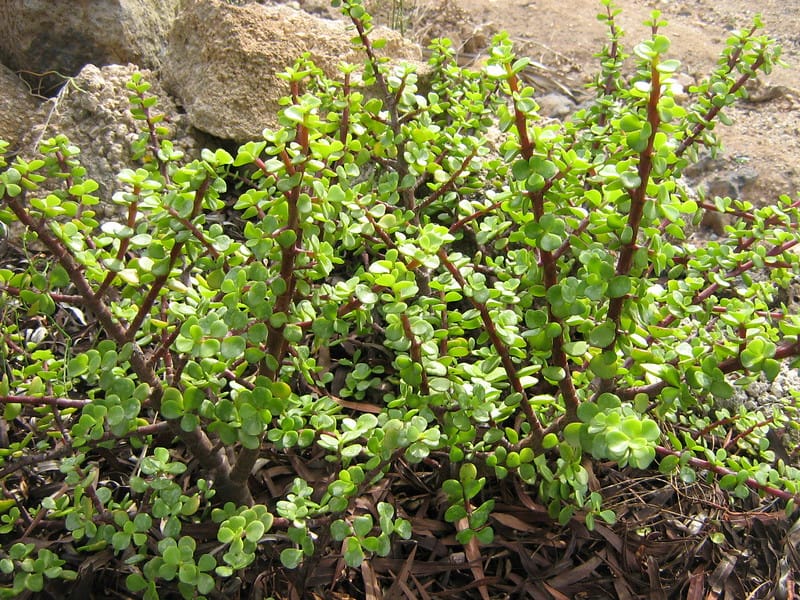
The attractive, evergreen succulent can grow to eight feet or more, in its natural enviornment. It has small, circular, fleshy, bright green foliage on reddish-brown stems.
The leaves of these plants are edible and have a tart flavor. In its native habitat, the plant is heavily browsed and eaten by elephants, wild game, and tortoises.
Elephants eat parts of the plant, and spit out the leaves and seeds, which help to propagate the plant.
It produces pink, star-shaped flowers in late winter to early spring, but rarely blooms the southwest desert. The flowers are a good source of nectar for birds and insects.
There is a variegated variety with a mixture of cream and green foliage.
Use this plant in containers, entryways, or patios. Combine it with other interesting low-water-use plants, or train it as a bonsai.
It is native to rocky slopes and dry river valleys of the eastern Cape of South Africa, and north into KwaZulu-Natal, Swaziland, Mpumalanga, and the Limpopo Province.
This plant grows quickly to form a large thicket of growth in its native habitat.
This plant likes full sun or light shade and is very is drought-resistant.
It also prefers occasional water, especially during the hot, dry summer. Do not over-water this plant, as it will immediately defoliate. It is hardy to thirty degrees Fahrenheit.
Senecio jacobsenii “Trailing Jade”
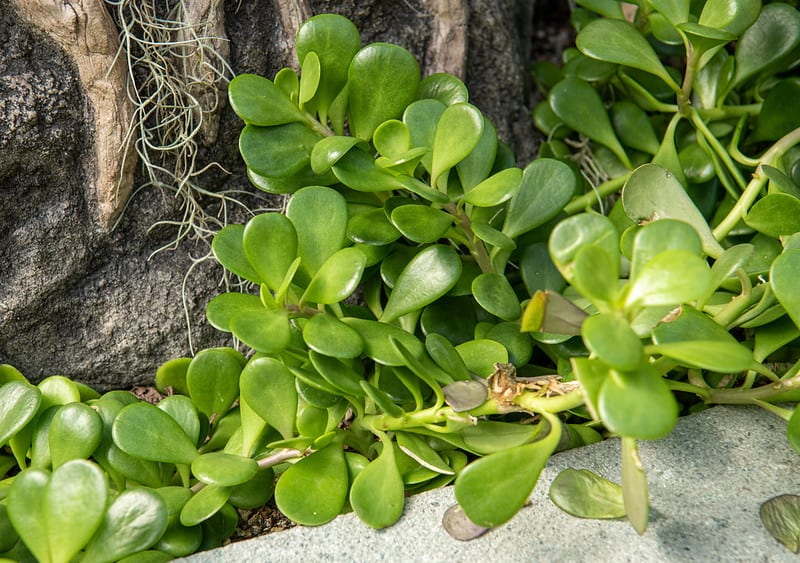
Trailing Jade (Senecio jacobsenii, also known as Kleinia petraea) (Jeffrey): Bears a strong resemblance to the Crassula Jades, but it is in fact unrelated.
This variety is native to the highlands of Tanzania and Kenya where it creeps along as a ground cover.
In cultivation it also shines in a hanging pots, which allows its thick stems to form a dense cascade up to 4.0′ long.
The smooth, spoon-shaped leaves of Trailing Jade stand upright on their stems. Moderate stress from bright sun or cool temperatures (40F-50F) can induce vibrant flushing from lilac to magenta.
This variety is a shy, unreliable bloomer. When they do appear, its showy flowers are bright orange and shaped like a paintbrush, but few find their smell appealing.
It is, however, simple to cut the blooms off without harming the plant.
Trailing Jade thrives in well-draining pots and gritty soil with at least 50% inorganic material, e.g. coarse sand, perlite, or pumice.
Water deeply enough for water to run out the drainage hole, but do not re-water until the soil has completely dried.
This plant tolerates pruning well and the cuttings can re-root and be transplanted.
Aloiampelos Ciliaris “Climbing Aloes”
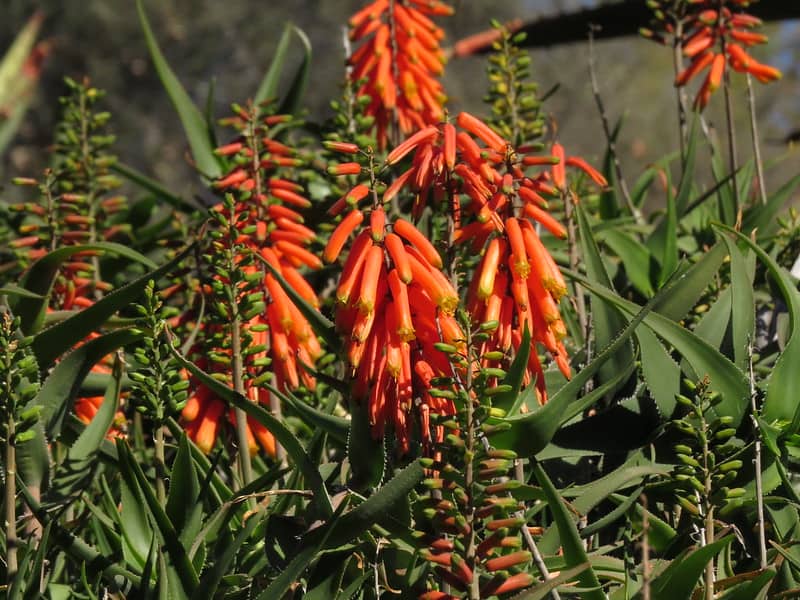
Aloiampelos ciliaris is a small, attractive, climbing Aloe and one of the easiest to cultivate. It is sparsely branched, but can climb to 10 m or even higher.
The base can sometimes be multi-stemmed and with age may become a rounded, swollen stem, bearing grey bark.
This is the fastest growing aloe of all the aloe-species. Some Aloes are now grouped into Aloiampelos.
Kleinia petraea “Trailing Jade”
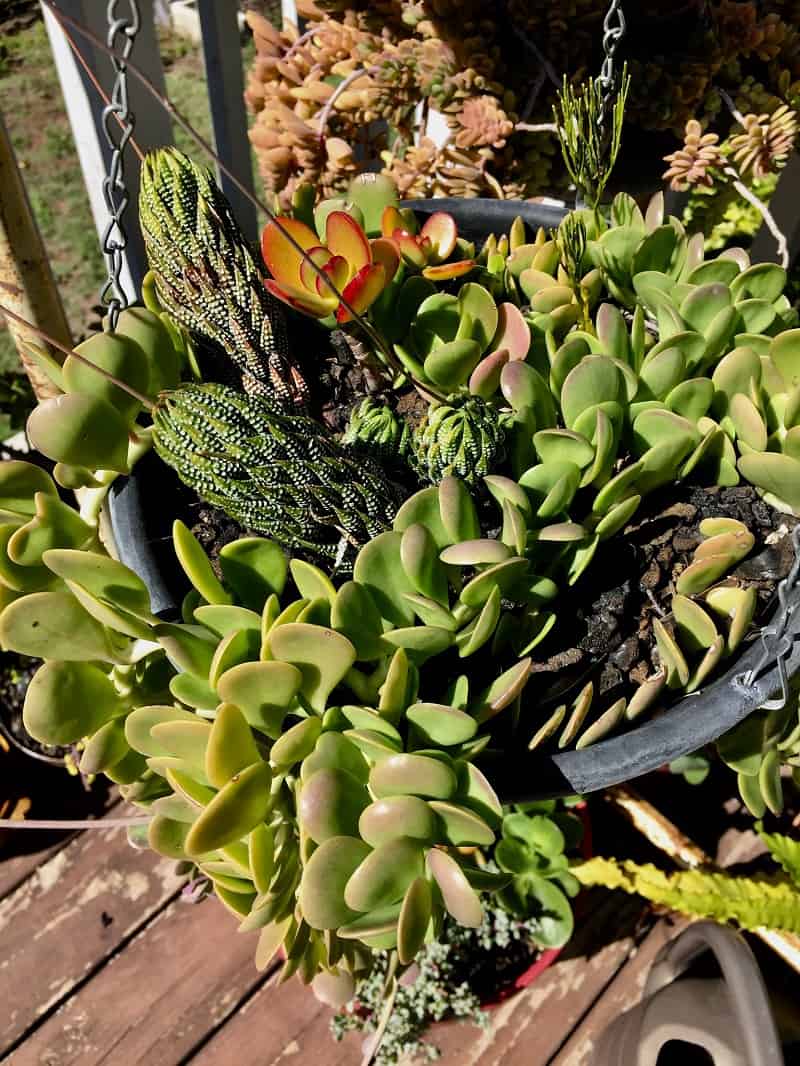
Kleinia petraea is a species of the genus Kleinia and family Asteraceae which was previously considered to be a species of Senecio.
Native to Kenya and Tanzania, it is colloquially known as creeping jade, trailing jade or weeping jade due to its resemblance to the unrelated Jade plant (Crassula ovata).
It is grown as a garden plant as a groundcover or in hanging baskets.
Trailing Jade also known as Senecio jacobsenii, is a creeping hanging succulent or can be used as a groundcover
- green fleshy egg shaped leaves
- leaves flush purple in winter months
- bright orange flowers
- stems can drape over edge of a basket up to 1.2 m
- prefer a good well draining potting mix
- keep water up to plant to prevent leaves looking dry & shrivelled
Crassula Sarmentosa “Variegated Trailing Jade”
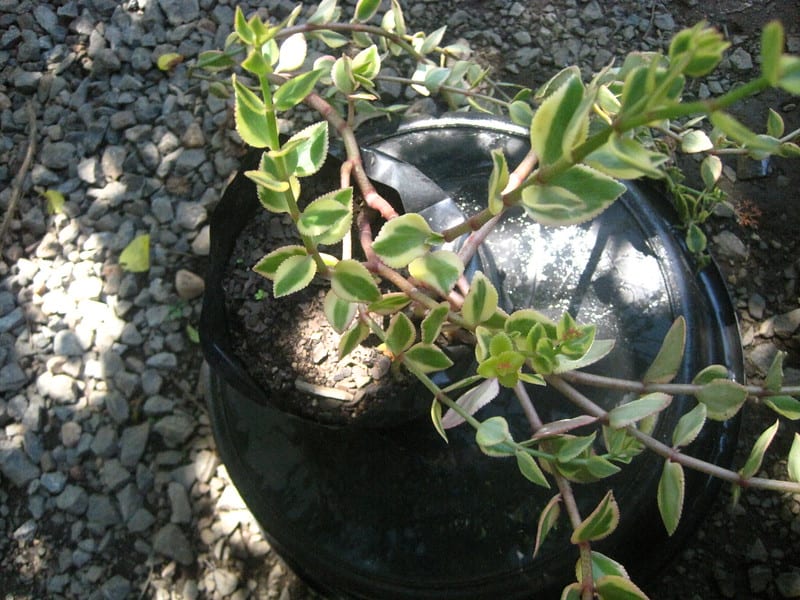
Crassula sarmentos ‘Comet’ or Variegated Trailing Jade is a scrambling succulent plant that grows up to 1′ tall and branches sparingly from the base with 3′ long reddish stems that arches outwards and upwards or trail down.
The stems bear up to 1 inch long ovate mid-green colored leaves that have finely serrated cream colored margins the leaves have brighter green color with red highlights along the white margins when grown in full sun.
Terminal rounded compact panicles of pink buds open to pure white flowers in late fall.
Variegated Crassula plants need full sun to develop their full coloration.
Avoid direct blasting sun in mid summer (with sun exposure the leaf develops a nice brownish tint), they do not do well in full shade as they tend to etiolate, fall over and rot easily.
They like well drained soils with easy access to moisture through addition of plenty of organic matter.
Keep watered in summer – they do not like drying out for long.. Reduce water in the winters.
Crassula perforata “String of Buttons”
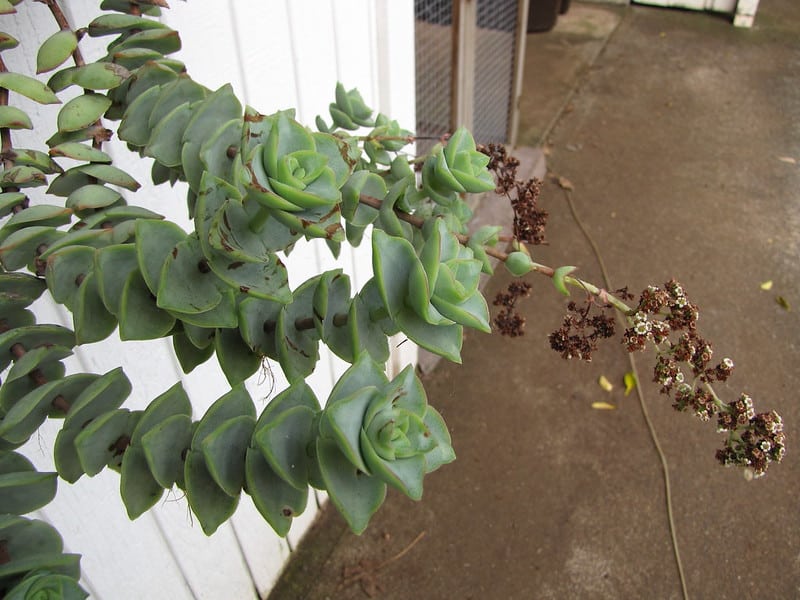
“String of Buttons” is a shrub succulent. It grows well indoors, and does well in terrariums.
The triangle-shaped leaves grow opposite each other and spiral around the stem, causing it to look stacked.
The gray-green leaves may have a pinkish tint to the edges if given enough light. Look for pale yellow flowers in the spring.
Crassula perforata “String of Buttons” is an easy-to-care-for succulent, perfect for beginners and indoor growing It is fast growing, doing well in container gardens or even terrariums.
Crassula perforata “String of Buttons” can be propagated from leaves, offsets, or stem cuttings.
Care fore succulents that hang down
Leaves
To propagate “String of Buttons” from leaves, gently twist the leaf from the stem. Be sure that the leaf you get is a “clean pull,” where no part of the leaf is left on the stem. This will give you a better chance of a successful propagation.
Allow the leaf to callous over for a day or two before placing it on well-draining soil.
Offsets
“String of Buttons” will produce small rosette offsets. Cut the offsets off from the main stem with a sharp, sterile knife or scissors. Allow the offsets to dry for one to two days before laying on well-draining soil.
Cuttings
To grow Crassula perforata from cuttings, use a sterile, sharp knife or pair of scissors. Remove a leaf from the main plant, and allow it to callous for several days before placing on well-draining soil. Water whenever the soil has dried out completely.
Where to Plant
Crassula perforata is not cold hardy, so if you live in a zone that gets colder than 20° F (-6.7° C), it’s best to plant this succulent in a container that can be brought indoors. It does well in full to partial sun.
Plant in an area of your garden that gets 6 hours of sunlight a day. If planting indoors, place in a room that gets a lot of sunlight, such as near a southern-facing window (if you’re in the Northern Hemisphere).